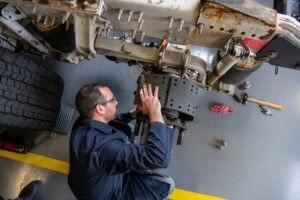Thinking about adding an autonomous truck or two to your fleet? If so, chances are that drivers’ reactions will be mixed, at best.
Thinking about adding an autonomous truck or two to your fleet? If so, chances are that drivers’ reactions will be mixed, at best.
After all, many drivers have expressed worries about the growing number of AI features in today’s Class 8 trucks, from inward-facing dash cam recorders to lane-assist sensors and automatic emergency braking.
Perhaps the biggest concern heard from drivers is fear that autonomous trucks will lead to companies snatching the steering wheel from their hands, shifting them from cabs to unemployment lines.
How can you integrate AI into your fleet without upsetting the proverbial apple cart?
According to Walter Grigg, director of industry partnerships at Torc Robotics, professional drivers have nothing to fear. In fact, he contends, drivers will be the ones who benefit most from this technology — simply because they won’t have to spend as many hours behind the wheel.
“Contrary to what many people may think, rather than leaving truckers without jobs, self-driving truck leaders plan to roll out hub-to-hub transportation models that take the long-haul tedium out of the picture, allowing truck drivers to handle the shorter, albeit more complex and engaging, routes,” he said.
“Human drivers will be on either end of hub — and they will be closer to home,” he said.
While full implementation of the hub-to-hub model featuring fully autonomous rigs is still many years away, Grigg says his company is working to ensure professional drivers will continue to play an integral role.
“If you are a professional driver today and you are safe and good at your job … you will have a job for as long as you want one,” he noted, adding that Torc’s target year for putting driverless rigs on the highways is 2027.
For drivers like Samuel Carter of Arkansas, who runs a route between Dallas and Little Rock on a weekly basis, the fear of being replaced by technology is there, but it’s not something he dwells on.
“I am young, 27, so I know that in my lifetime I will likely have to deal with self-driving trucks and see how that plays out in my career,” he said. “I am not really worried about being replaced as a driver, but it is a little concerning. I just try not to worry about it and will deal with that when it comes time to.”
Of course, there are numerous questions about the safety of autonomous systems.
Phil Koopman, a professor at Carnegie Mellon University, specializes in studies of vehicle automation safety.
He agrees with Grigg that self-driving trucks can theoretically be safer than human-driven ones — for the very reason that they lack drivers who might become distracted or impaired. However, he cautions, computers will inevitably make errors. Just how the trucks will fare in real-world situations will depend on the quality of their safety engineering, he says.
With billions of dollars in investments at stake, Koopman wonders how the companies will balance safety decisions against cost concerns.
“Everything I see indicates they’re trying to do the right thing,” he said. “But the devil is in the details.”
On the test track, reporters recently saw autonomous trucks powered by Aurora technology successfully avoid simulated road obstacles, including pedestrians, a blown tire and even a horse.
Keep in mind, however: In these tests, the trucks were running at only 35 mph in a controlled environment, with no unexpected occurrences. These same trucks are being tested by Aurora — with human safety drivers on board — at speeds of 65 mph or higher on Texas freeways.
Attorney Amy Witherite, founder of a law firm that specializes in vehicle accident cases, recently spoke out about what she calls “the dangers of driverless vehicles on the road.”
“We have already seen problems with both autonomous trucks as well as vehicles such as Tesla with an autopilot feature,” she said. “The danger and severity of accidents will be multiplied a hundredfold when the accident involves a tractor-trailer versus a car.”
Witherite points to recent reports of autonomous vehicles posing unnecessary risks to the general public. The state of California just this year called a halt to the use of autonomous taxis in the San Francisco area after the vehicles were involved in several incidents.
Compounding these concerns, self-driving truck company Waymo recently recalled 444 self-driving vehicles after two minor collisions in quick succession in Arizona because a software error could result in them inaccurately predicting the movement of a towed vehicle.
Alain Kornhauser, head of autonomous vehicle studies at Princeton University, recently told the Associated Press that he drove a borrowed Tesla for two weeks and found that it consistently spotted pedestrians and detected other drivers.
While the software performs well most of the time, Kornhauser said he had to take control when the Tesla made moves that “scared” him, warning that self-driving vehicles aren’t ready to be used without human supervision.
“This thing,” he said, “is not at a point where it can go anywhere.”
The software that enables automated driving in passenger vehicles mirrors that being installed and tested in larger vehicles like semi-trucks.
Tech developers note that automated sensors provide advance warning of dangers.
During the previously mentioned test runs, Aurora trucks “spotted” obstacles more than a quarter mile away and acted immediately to avoid them. Chris Urmson, CEO of Aurora, says the trucks’ laser sensors can detect people walking on a highway at night, far beyond the distance of headlights.
Already, several trucking companies are partnering with autonomous tech providers to roll out self-driving Class 8 rigs on test runs between major cities. Aurora and Torc are among the tech firms working on autonomous semis and trucking hubs.
Kodiak Robotics and truck stop giant Pilot Co. have planned a Pilot travel center in Villa Rica, Georgia, which will be used by Kodiak to launch and land autonomous trucks. Company officials say the facility will serve as a hub for drivers to pick up and drop off first-and last-mile deliveries.
The Villa Rica truckport will support Kodiak’s 18,000-mile-long autonomous deployment network, the industry’s largest and most robust set of mapped routes for self-driving trucks.
Last summer, Torc announced plans to collaborate with C.R. England on a pilot program using C.R. England’s temperature-controlled loads and Torc’s fleet of Level 4 autonomous test trucks for long-haul applications.
At Level 4, the interaction between human and machine lowers as the vehicle’s capability increases. Steering, braking, accelerating and monitoring the environment are taken out of the driver’s hands, as well as changing lanes, turning and signaling, according to navigation company TomTom. However, with Level 4 technology, a human still has the option to manually override the system.
Chad England, CEO of C.R. England, says he believes autonomous trucking will eventually lead to the company expanding its network safely, with high levels of service to its customers, all while enhancing the quality of existing driver jobs.
“Specifically, by adding autonomous lanes to our network, we can expand our customer offerings and create more structured jobs for drivers at both ends of autonomous runs,” England said. “Torc’s deep integration with Daimler Truck AG makes our two organizations a perfect fit for piloting this new technology.”
Back at Torc’s headquarters, Grigg, a CDL holder himself, seeks to reassure drivers who think they’ll be replaced by technology. He’s been out on the road many times in a big rig and says he understands the way drivers think. He appreciates their points of view.
In short, he says, part of Torc’s goal is to help make truckers’ lives easier and healthier.
Bringing autonomy to trucking can help drivers by taking them out of the cab for days on end and allowing them to work closer to home, with shorter routes. That means less sitting and more body movement, which is better for the heart and overall health, he said.
“Truck drivers are the heartbeat of the American economy and our supply chains — but what does the average heart health of a trucker look like?” Grigg said. “There’s quite a bit of historic data … that point out the higher likelihood of diabetes, heart disease and unhealthy habits like smoking that are prevalent in the truck driver population as a result of long, arduous hours on the road.
“Rest assured, we have the best interests of the drivers in mind with all of our plans,” he concluded.
Born in Pine Bluff, Arkansas, and raised in East Texas, John Worthen returned to his home state to attend college in 1998 and decided to make his life in The Natural State. Worthen is a 20-year veteran of the journalism industry and has covered just about every topic there is. He has a passion for writing and telling stories. He has worked as a beat reporter and bureau chief for a statewide newspaper and as managing editor of a regional newspaper in Arkansas. Additionally, Worthen has been a prolific freelance journalist for two decades, and has been published in several travel magazines and on travel websites.








